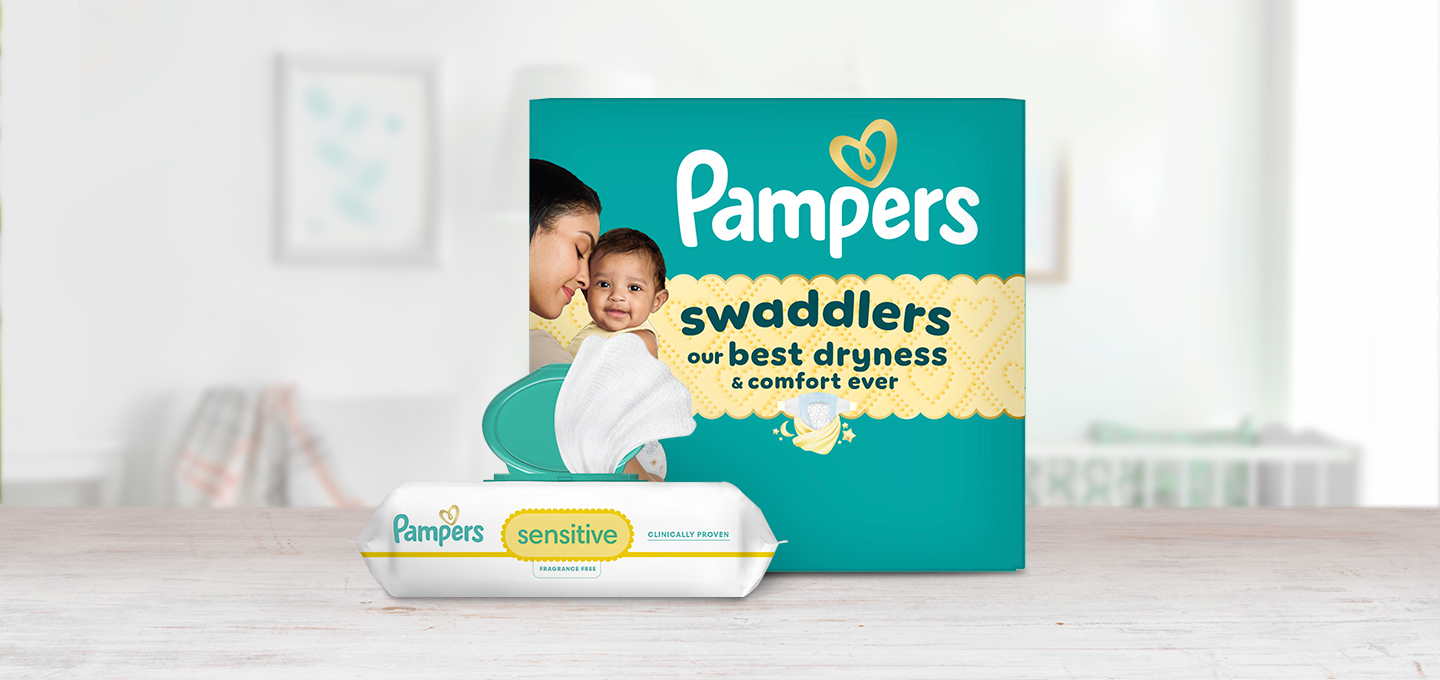- About Us
- Quality and Safety
- Frequently Asked Questions: Pampers Quality, Safety, and Ingredients

Frequently Asked Questions: Pampers Quality, Safety, and Ingredients
We understand you want the very best for your baby—that’s why we’re answering all your questions on Pampers quality, safety, and ingredients below.
Have a question that we didn’t address? Call our support team at 1-800-726-7377 or contact us online.
FREQUENTLY ASKED QUESTIONS
Yes! All Pampers products are safe. Our diapers, wipes, and training pants use carefully evaluated ingredients that are common in most diapers and wipes and are safely used by millions of babies every day.
The Pampers Safety Promise ensures that every element of our products are safe for baby.
Step 1: Ensure Safety at the Source
Step 2: Assess Manufactured Components
Step 3: Evaluate Every Product
Step 4: Monitor Again (and Again)
Our safety team works with medical professionals and safety experts to evaluate every ingredient for potential risks. We also invest in clinical safety studies and monitor products through safety checks, both on the production line and at home.
Our ingredients are carefully chosen based on safety profiles and their demonstrated effectiveness for keeping baby’s skin dry and healthy. We evaluate every ingredient to ensure it’s safe before it ever comes in contact with your baby’s skin.
While diaper rash is one of the most common pediatric conditions, it is not caused by diapers. Diaper rash is caused by a combination of factors like excessive skin hydration, increase in pH, and irritants in bowel movements and friction.
pH is the level of which something is acidic or basic, on a scale of 1-14. Healthy infant skin ranges from 4.7-6, but urine and stool can increase the pH, making the skin more susceptible to rashes.
Taped diapers use strips (or “tape”) to secure the diaper to your baby’s waist. This allows for a custom and adjustable fit for your baby and can be especially useful for newborns whose umbilical cords have not fallen off.
Diaper pants are soft and stretchy. We’ve designed these diapers for infants 6+ months old, especially those who are beginning to crawl and flip over. These diapers can be pulled on while your baby is standing up and have tear-away sides for easy removal.
Pampers diapers are composed of a topsheet, stretchy fastenings, a dual acquisition layer and absorbent core, flexible leg cuffs and elastics, fun drawings, adhesives, and a waterproof backsheet. Some diapers also include a mild ointment and a wetness indicator.
No. Adhesives are used throughout the diaper to keep the parts of the diaper together and avoid leakage. These adhesives are solvent-free and do not come into direct contact with your baby’s skin.
Pampers diapers contain absorbent gelling material that can absorb nearly 30 times its weight. In rare cases, you may notice small gel particles on your baby’s skin—this is the absorbent material and can easily be removed by wiping gently.
These beads are part of our absorbent gelling material, which has a long history of safe use in diapers. If you notice small gel particles on your baby’s skin, it is the absorbent material and can be easily removed by gentle wiping.
Like all materials and ingredients in our diapers, super-absorbent gel is safe as used in our diapers. Pampers conducts tests to evaluate the safety of this ingredient — adding to the large body of evidence that shows the safety of this gel for babies' skin.
Some Pampers diapers contain a small amount of fragrance within the diaper and away from baby’s skin. Pampers diapers with scent are not expected to cause any allergic reaction. If you’re interested in an unscented option, our Pampers® Pure Protection products are fragrance free.
It’s important to keep diapers where they should be—on your baby’s bottom. Do not let your baby put a diaper in his/her mouth and always discard any diaper that has torn or become unsealed. Always read the warning label on all packaging.
Unused diapers should be stored in an area protected from extreme heat and humidity. Pampers recommends diapers be kept in a dry area where the temperature is 85 degrees Fahrenheit or less, and away from products with fragrances.
Some babies need to be changed up to 10 times a day, depending on how often they are wet/soiled. You can tell a Pampers diaper is wet if the indicator strip goes from yellow to blue, or if you feel lumps in the absorbent material.
Every product description on our website has the appropriate diaper size for your baby, depending on their weight. Some important reminders: choose a diaper that doesn’t sag or gap to prevent leaks. Also keep in mind that when you increase the diaper size, it will gain absorbency.
If you don’t have an infant scale, use subtraction! Weigh yourself on a scale, then look at the weight while holding your baby. Subtract your weight to see how much your baby weighs. This will help you choose the correct diaper size for your baby.
Our wipes are made from a combination of safe fibers like cotton, viscose, polyester, lyocell, and polypropylene that give the wipe its soft, flexible shape. Our wipes contain a pH buffering lotion to help restore the skin back to its natural pH level.
No, Pampers wipes don’t cause diaper rash. Sensitive wipes are specifically designed to be extra gentle on your baby’s skin. All Pampers wipes are better than using cotton and water, containing at least 97 percent purified water and a gentle cleanser and pH-balancing lotion.
Yes, Pampers® Sensitive™ Wipes are both fragrance free and hypoallergenic. Our wipes have also been independently reviewed and accredited as skin safe by the Skin Health Alliance.
Yes, all colors on Pampers products are evaluated for safety. These colors are commonly used in other consumer products, such as food packaging and contact lenses.
No, Pampers does not use any disperse dyes in any products.
All Pampers diapers and wipes are chlorine free.
No, elemental chlorine bleaching has not been the practice for decades. Our suppliers use a process called Elemental Chlorine Free or ECF. Please visit our Materials and Safety page to learn more.
No, Pampers does not use methylisothiazolinone or methylchloroisothiazolinone in any of our products. We have an extensive list of ingredients we promise to never use in our products.
Two recent studies (1, 2), found that using a super-absorbent diaper and a wipe with pH balancing lotion helped restore the skin’s natural pH and improve the skin condition. Pampers® Sensitive™ Wipes and Pampers® Swaddlers™ diaper are the perfect duo.
Yes, Pampers baby wipes are safe to use on other body parts, including the face, and can be used at every diaper change.
Yes, Pampers baby wipes have been clinically tested to ensure there are no allergens or skin irritation. The wipes are clinically shown to be mild for sensitive skin—and are found to be even milder than a washcloth and water.
Pampers and our trusted partners around the globe manufacture our diapers and wipes. We have more than 30 manufacturing facilities across 25 countries, and we shepherd the process from sourcing, production, and distribution to ensure quality every step of the way. Our diapers are available in more than 100 countries around the world.
Pampers has worked to minimize our environmental footprint for years. Our facilities use 100% renewable electricity and ensure that no manufacturing waste is sent to landfills. We also collaborate with our suppliers to develop carbon reduction strategies via the Sustainable Supple Chain Innovation Program.
Pampers was born in 1961! After several redesigns, tests and manufacturing developments, Pampers was granted its first patent in 1964. While there were other disposable diapers, the combination of Pampers’ superior performance and reasonable pricing created the disposable diaper category in the U.S.
Yes, Pampers is a proud member of the P&G product family. In fact, a well-known P&G researcher, Victor Mills, was the inventor of the disposable diaper.
Related Articles
How We Wrote This Article The information in this article is based on the expert advice found in trusted medical and government sources, such as the American Academy of Pediatrics and the American College of Obstetricians and Gynecologists, as well as Pampers’ own safety and product experts. When applicable, you can find a full list of sources used for this article below. The content on this page should not replace professional medical advice. Always consult medical professionals for full diagnosis and treatment.
Read more about About Us
Related Articles
Join a World of Support
through Pregnancy and Parenthood.
![toy]()
TRACK WITH TOOLS
![baby]()
LEARN WITH EXPERTS
![Gift]()
GET REWARDED

Where You Already Belong





